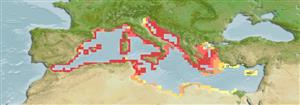Environment: milieu / climate zone / depth range / distribution range
Οικολογία
Θαλασσινό(ά) βενθικό(ς); εύρος βάθους ? - 30 m (Ref. 80021). Subtropical; 46°N - 30°N, 6°W - 36°E
Mediterranean Sea, endemic.
Μέγεθος / Βάρος / Age
Maturity: Lm ? range ? - ? cm
Max length : 16.5 cm TL αρσενικό/απροσδιόριστο; (Ref. 122896); μεγ. δημοσιευμένο βάρος: 44.23 g (Ref. 122896)
Occur inshore, on sand or mud near seagrass (Ref. 4696). Breeding males are dusky (Ref. 4696).
Life cycle and mating behavior
Γεννητική Ωρίμανση | Αναπαραγωγή | Γεννοβολία | Αβγά | Γονιμότητα | Προνύμφες
Breeding males are dusky (Ref. 4696).
Miller, P.J., 1986. Gobiidae. p. 1019-1085. In P.J.P. Whitehead, M.-L. Bauchot, J.-C. Hureau, J. Nielsen and E. Tortonese (eds.) Fishes of the North-eastern Atlantic and the Mediterranean. Volume 3. UNESCO, Paris. (Ref. 4696)
IUCN Red List Status (Ref. 130435: Version 2024-1)
Threat to humans
Harmless
Human uses
Εργαλεία
Special reports
Download XML
Διαδικτυακές πηγές
Estimates based on models
Preferred temperature (Ref.
123201): 17.6 - 21.2, mean 19.1 °C (based on 426 cells).
Phylogenetic diversity index (Ref.
82804): PD
50 = 0.5000 [Uniqueness, from 0.5 = low to 2.0 = high].
Bayesian length-weight: a=0.00741 (0.00429 - 0.01280), b=3.12 (2.98 - 3.26), in cm total length, based on LWR estimates for this species & Genus-body shape (Ref.
93245).
Τροφικό Επίπεδο (Ref.
69278): 3.3 ±0.39 se; based on food items.
Ελαστικότητα (Ref.
120179): Υψηλό, ελάχιστος χρόνος για διπλασιασμό πληθυσμού < 15 μήνες (Preliminary K or Fecundity.).
Fishing Vulnerability (Ref.
59153): Low vulnerability (10 of 100).
Nutrients (Ref.
124155): Calcium = 185 [86, 409] mg/100g; Iron = 1.22 [0.65, 2.56] mg/100g; Protein = 18 [16, 20] %; Omega3 = 0.217 [0.093, 0.434] g/100g; Selenium = 19.2 [9.0, 41.6] μg/100g; VitaminA = 18.1 [5.0, 64.6] μg/100g; Zinc = 1.13 [0.75, 1.72] mg/100g (wet weight);
